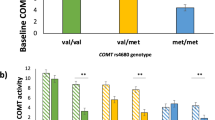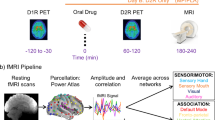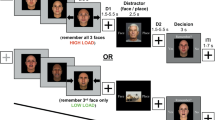Abstract
Prefrontal cortical dopamine (DA) regulates various executive cognitive functions, including attention and working memory. Efforts to enhance prefrontal-related cognition, which have focused on catecholaminergic stimulant drugs, have been unsatisfactory. Recently, the demonstration that a functional polymorphism in the catecholamine-O-methyltransferase (COMT) gene impacts prefrontal cognition raises the possibility of a novel pharmacological approach for the treatment of prefrontal lobe executive dysfunction. To explore in a proof of concept study the effects of tolcapone, a CNS penetrant specific COMT inhibitor, we performed a randomized, double blind, placebo controlled, and crossover design of this drug in normal subjects stratified by COMT (val158met) genotype. COMT enzyme activity was determined in peripheral blood. Forty-seven normal volunteers with no family history of psychiatric disorders underwent neuropsychological testing and 34 of those subjects underwent physiological measurement of prefrontal information processing assessed by blood oxygen level-dependent functional magnetic resonance imaging (fMRI). We found significant drug effects on measures of executive function and verbal episodic memory and a significant drug by genotype interaction on the latter, such that individuals with val/val genotypes improved, whereas individuals with met/met genotypes worsened on tolcapone. fMRI revealed a significant tolcapone-induced improvement in the efficiency of information processing in prefrontal cortex during a working memory test. This study demonstrates enhancement of prefrontal cortical function in normal human subjects with a nonstimulant drug having COMT inhibitory activity. Our results are consistent with data from animal studies and from computational models of the effects of selective enhancement of DA signaling in the prefrontal cortex.
Similar content being viewed by others
Log in or create a free account to read this content
Gain free access to this article, as well as selected content from this journal and more on nature.com
or
References
Ceravolo R, Piccini P, Bailey DL, Jorga KM, Bryson H, Brooks DJ (2002). 18F-dopa PET evidence that tolcapone acts as a central COMT inhibitor in Parkinson's disease. Synapse 43: 201–207.
Chen J, Lipska BK, Halim N, Ma QD, Matsumoto M, Melhem S et al (2004). Functional analysis of genetic variation in catechol-O-methyltransferase (COMT): effects on mRNA, protein, and enzyme activity in postmortem human brain. Am J Hum Genet 75: 807–821.
Cools R, Stefanova E, Barker RA, Robbins TW, Owen AM (2002). Dopaminergic modulation of high-level cognition in Parkinson's disease: the role of the prefrontal cortex revealed by PET. Brain 125: 584–594.
Da Prada M, Zurcher G, Kettler R, Colzi A (1991). New Therapeutic Strategies in Parkinson's Disease: Inhibition of MAO-B by Ro 19-6327 and of COMT by Ro 40-7592. Plenum Press: New York.
de Frias CM, Annerbrink K, Westberg L, Eriksson E, Adolfsson R, Nilsson LG (2004). COMT gene polymorphism is associated with declarative memory in adulthood and old age. Behav Genet 34: 533–539.
D’Esposito M, Postle BR, Rypma B (2000). Prefrontal cortical contributions to working memory: evidence from event-related fMRI studies. Exp Brain Res 133: 3–11.
Diaz-Asper C, Goldberg T, Kolachana B, Mazzanti C, Callicot J, Straub R et al (2005). Genetic variation in COMT effects on working memory function in Schizophrenic patients and healthy controls (submitted).
Egan MF, Goldberg TE, Kolachana BS, Callicott JH, Mazzanti CM, Straub RE et al (2001). Effect of COMT Val108/158 Met genotype on frontal lobe function and risk for schizophrenia. Proc Natl Acad Sci USA 98: 6917–6922.
Forsberg M, Lehtonen M, Heikkinen M, Savolainen J, Jarvinen T, Mannisto P (2003). Pharmacokinetics and pharmacodynamics of entacapone and tolcapone after acute and repeated administration: a comparative study in the rat. J Pharmacol Exp Ther 304: 498–506.
Gasparini M, Fabrizio E, Bonifati V, Meco G (1997). Cognitive improvement during tolcapone treatment in Parkinson's disease. J Neural Transm 104: 887–894.
Gogos JA, Morgan M, Luine V, Santha M, Ogawa S, Pfaff D et al (1998). Catechol-O-methyltransferase-deficient mice exhibit sexually dimorphic changes in catecholamine levels and behavior. Proc Natl Acad Sci USA 95: 9991–9996.
Gold JM, Carpenter C, Randolph C, Goldberg TE, Weinberger DR (1997). Auditory working memory and Wisconsin Card Sorting Test performance in schizophrenia. Arch Gen Psychiatry 54: 159–165.
Goldberg TE, Egan MF, Gscheidle T, Coppola R, Weickert T, Kolachana BS et al (2003). Executive subprocesses in working memory: relationship to catechol-O-methyltransferase Val158Met genotype and schizophrenia. Arch Gen Psychiatry 60: 889–896.
Gourovitch ML, Kirkby BS, Goldberg TE, Weinberger DR, Gold JM, Esposito G et al (2000). A comparison of rCBF patterns during letter and semantic fluency. Neuropsychology 14: 353–360.
Guldberg HC, Marsden CA (1975). Catechol-O-methyl transferase: pharmacological aspects and physiological role. Pharmacol Rev 27: 135–206.
Hall H, Halldin C, Guilloteau D, Chalon S, Emond P, Besnard J et al (1999). Visualization of the dopamine transporter in the human brain postmortem with the new selective ligand [125I]PE2I. NeuroImage 9: 108–116.
Hardy GH (1908). Mendelian proportions in a mixed population. Science 28: 49–50.
Ho BC, Wassink TH, O’Leary DS, Sheffield VC, Andreasen NC (2005). Catechol-O-methyl transferase Val(158)Met gene polymorphism in schizophrenia: working memory, frontal lobe MRI morphology and frontal cerebral blood flow. Mol Psychiatry 10: 287–298.
Jorga K, Fotteler B, Heizmann P, Gasser R (1999). Metabolism and excretion of tolcapone, a novel inhibitor of catechol-O-methyltransferase. Br J Clin Pharmacol 48: 513–520.
Jorga KM (1998). Pharmacokinetics, pharmacodynamics, and tolerability of tolcapone: a review of early studies in volunteers. Neurology 50: S31–S38.
Karoum F, Chrapusta SJ, Egan MF (1994). 3-Methoxytyramine is the major metabolite of released dopamine in the rat frontal cortex: reassessment of the effects of antipsychotics on the dynamics of dopamine release and metabolism in the frontal cortex, nucleus accumbens, and striatum by a simple two pool model. J Neurochem 63: 972–979.
Li YH, Wirth T, Huotari M, Laitinen K, MacDonald E, Mannisto PT (1998). No change of brain extracellular catecholamine levels after acute catechol-O-methyltransferase inhibition: a microdialysis study in anaesthetized rats. Eur J Pharmacol 356: 127–137.
Liljequist R, Haapalinna A, Ahlander M, Li YH, Mannisto PT (1997). Catechol O-methyltransferase inhibitor tolcapone has minor influence on performance in experimental memory models in rats. Behav Brain Res 82: 195–202.
Lloyd KG, Davidson L, Hornykiewicz O (1975). The neurochemistry of Parkinson's disease: effect of L-dopa therapy. J Pharmacol Exp Ther 195: 453–464.
Mannisto PT, Kaakkola S (1999). Catechol-O-methyltransferase (COMT): biochemistry, molecular biology, pharmacology, and clinical efficacy of the new selective COMT inhibitors. Pharmacol Rev 51: 593–628.
Matsumoto M, Weickert CS, Beltaifa S, Kolachana B, Chen J, Hyde TM et al (2003). Catechol O-methyltransferase (COMT) mRNA expression in the dorsolateral prefrontal cortex of patients with schizophrenia. Neuropsychopharmacology 28: 1521–1530.
Mattay VS, Callicott JH, Bertolino A, Heaton I, Frank JA, Coppola R et al (2000). Effects of dextroamphetamine on cognitive performance and cortical activation. NeuroImage 12: 268–275.
Mattay VS, Goldberg TE, Fera F, Hariri AR, Tessitore A, Egan MF et al (2003). Catechol O-methyltransferase val158-met genotype and individual variation in the brain response to amphetamine. Proc Natl Acad Sci USA 100: 6186–6191.
Mattay VS, Tessitore A, Callicott JH, Bertolino A, Goldberg TE, Chase TN et al (2002). Dopaminergic modulation of cortical function in patients with Parkinson's disease. Ann Neurol 51: 156–164.
Mazei MS, Pluto CP, Kirkbride B, Pehek EA (2002). Effects of catecholamine uptake blockers in the caudate-putamen and subregions of the medial prefrontal cortex of the rat. Brain Res 936: 58–67.
McNair D, Lorr M (1981). ITS Manual for the Profile of Mood States. Multi-health System, Inc.: San Diego, CA.
Moron JA, Brockington A, Wise RA, Rocha BA, Hope BT (2002). Dopamine uptake through the norepinephrine transporter in brain regions with low levels of the dopamine transporter: evidence from knock-out mouse lines. J Neurosci 22: 389–395.
Pozzi L, Invernizzi R, Cervo L, Vallebuona F, Samanin R (1994). Evidence that extracellular concentrations of dopamine are regulated by noradrenergic neurons in the frontal cortex of rats. J Neurochem 63: 195–200.
Seamans JK, Yang CR (2004). The principal features and mechanisms of dopamine modulation in the prefrontal cortex. Prog Neurobiol 74: 1–58.
Sesack SR, Hawrylak VA, Matus C, Guido MA, Levey AI (1998). Dopamine axon varicosities in the prelimbic division of the rat prefrontal cortex exhibit sparse immunoreactivity for the dopamine transporter. J Neurosci 18: 2697–2708.
Syvanen AC, Tilgmann C, Rinne J, Ulmanen I (1997). Genetic polymorphism of catechol-O-methyltransferase (COMT): correlation of genotype with individual variation of S-COMT activity and comparison of the allele frequencies in the normal population and parkinsonian patients in Finland. Pharmacogenetics 7: 65–71.
Tunbridge EM, Bannerman DM, Sharp T, Harrison PJ (2004). Catechol-O-methyltransferase inhibition improves set-shifting performance and elevates stimulated dopamine release in the rat prefrontal cortex. J Neurosci 24: 5331–5335.
Weinberg W (1908). ber den Nachweis der Vererbung beim Menschen. Jahresh Ver Vaterl Naturk Württemb 64: 368–382.
Weinberger DR, Egan MF, Bertolino A, Callicott JH, Mattay VS, Lipska BK et al (2001). Prefrontal neurons and the genetics of schizophrenia. Biol Psychiatry 50: 825–844.
Zurcher G, Colzi A, Da Prada M (1990a). Ro 40-7592: inhibition of COMT in rat brain and extracerebral tissues. J Neural Transm Suppl 32: 375–380.
Zurcher G, Dingemanse J, Da Prada M (1991). Ro-40-7592, A Potent Inhibitor of Extracerebral and Brain Catechol-O-methyltransferase: Preclinical and Clinical Findings. John Libbey SRL: Rome.
Zurcher G, Keller HH, Kettler R, Borgulya J, Bonetti EP, Eigenmann R et al (1990b). Ro 40-7592, a novel, very potent, and orally active inhibitor of catechol-O-methyltransferase: a pharmacological study in rats. Adv Neurol 53: 497–503.
Acknowledgements
We thank the following persons for their excellent assistance: Ben Kosiorowski, Julie Kohn, Francis Glenn, Mary Weirich, Denise Niner, Saumitra Das, Cayenne Nikoosh Carlo, Gerald Overman, and the 4-E Unit nursing staff.
Author information
Authors and Affiliations
Corresponding author
Additional information
Conflict of Interests
No author has conflict of interests related to the present research.
Rights and permissions
About this article
Cite this article
Apud, J., Mattay, V., Chen, J. et al. Tolcapone Improves Cognition and Cortical Information Processing in Normal Human Subjects. Neuropsychopharmacol 32, 1011–1020 (2007). https://doi.org/10.1038/sj.npp.1301227
Received:
Revised:
Accepted:
Published:
Issue date:
DOI: https://doi.org/10.1038/sj.npp.1301227
Keywords
This article is cited by
-
Genetic profile for dopamine signaling predicts brain functional reactivity to repetitive transcranial magnetic stimulation
European Archives of Psychiatry and Clinical Neuroscience (2023)
-
Evidence for anti-inflammatory effects and modulation of neurotransmitter metabolism by Salvia officinalis L.
BMC Complementary Medicine and Therapies (2022)
-
Catechol-O-Methyltransferase Effects on Smoking: a Review and Proof of Concept of Sex-Sensitive Effects
Current Behavioral Neuroscience Reports (2022)
-
Novel, non-nitrocatechol catechol-O-methyltransferase inhibitors modulate dopamine neurotransmission in the frontal cortex and improve cognitive flexibility
Psychopharmacology (2020)
-
Estrogen Signaling in Alzheimer’s Disease: Molecular Insights and Therapeutic Targets for Alzheimer’s Dementia
Molecular Neurobiology (2020)



